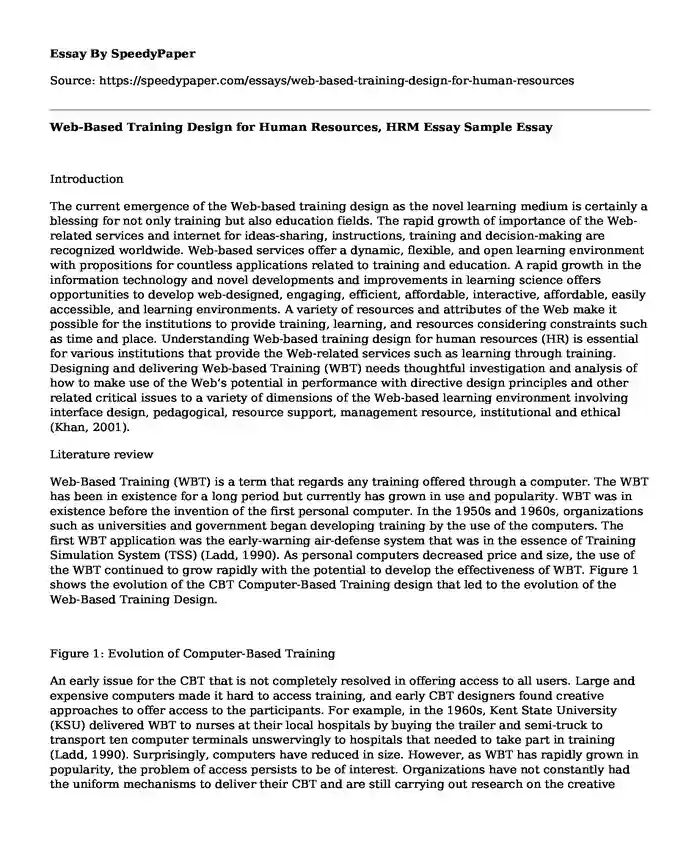
| Type of paper: | Essay |
| Categories: | Human resources |
| Pages: | 3 |
| Wordcount: | 730 words |
Introduction
The current emergence of the Web-based training design as the novel learning medium is certainly a blessing for not only training but also education fields. The rapid growth of importance of the Web-related services and internet for ideas-sharing, instructions, training and decision-making are recognized worldwide. Web-based services offer a dynamic, flexible, and open learning environment with propositions for countless applications related to training and education. A rapid growth in the information technology and novel developments and improvements in learning science offers opportunities to develop web-designed, engaging, efficient, affordable, interactive, affordable, easily accessible, and learning environments. A variety of resources and attributes of the Web make it possible for the institutions to provide training, learning, and resources considering constraints such as time and place. Understanding Web-based training design for human resources (HR) is essential for various institutions that provide the Web-related services such as learning through training. Designing and delivering Web-based Training (WBT) needs thoughtful investigation and analysis of how to make use of the Web’s potential in performance with directive design principles and other related critical issues to a variety of dimensions of the Web-based learning environment involving interface design, pedagogical, resource support, management resource, institutional and ethical (Khan, 2001).
Literature review
Web-Based Training (WBT) is a term that regards any training offered through a computer. The WBT has been in existence for a long period but currently has grown in use and popularity. WBT was in existence before the invention of the first personal computer. In the 1950s and 1960s, organizations such as universities and government began developing training by the use of the computers. The first WBT application was the early-warning air-defense system that was in the essence of Training Simulation System (TSS) (Ladd, 1990). As personal computers decreased price and size, the use of the WBT continued to grow rapidly with the potential to develop the effectiveness of WBT. Figure 1 shows the evolution of the CBT Computer-Based Training design that led to the evolution of the Web-Based Training Design.
Figure 1: Evolution of Computer-Based Training
An early issue for the CBT that is not completely resolved in offering access to all users. Large and expensive computers made it hard to access training, and early CBT designers found creative approaches to offer access to the participants. For example, in the 1960s, Kent State University (KSU) delivered WBT to nurses at their local hospitals by buying the trailer and semi-truck to transport ten computer terminals unswervingly to hospitals that needed to take part in training (Ladd, 1990). Surprisingly, computers have reduced in size. However, as WBT has rapidly grown in popularity, the problem of access persists to be of interest. Organizations have not constantly had the uniform mechanisms to deliver their CBT and are still carrying out research on the creative approaches to offer uniform access. Also, distance learning evolved due to the evolvement of the Web-Based Training. Distance learning has its foundations in association courses and can involve any program where learners require not being physically present in the room.
During the time when organization resources, funding, and staff are lessening, and travel limitations are escalating, attention to adequate strategies of Human Resource (HR) training is essential. The literature review has been conducted so as to contact the delivery and development of the Human Resource training for the different organizations. The literature review was gathered and the ideas summarized from different perceptions such as the revolution of the WBT involving the Web-Based Training Distance Learning (WBTDL) and Computer-Based Training (CBT). Also, the literature highlights how the training are designed so as to benefit the Human Resource. The Web-Based Learning Environment and the WBT components and features connected with the WBT environments are discussed so as to understand the benefits of the WBT design for the Human Resource.
Analysis
Web-Based Training Design
In designing training in a Web, we are required to explore a variety of issues including the eight dimensions of the Web-based design learning environment that can assist us think about various knowledge features suitable for our target Human Resource. The competencies of various resources and attributes of Web must be examined to observe how they see how they can be appropriate utilized to develop various Web-Based Training features. Also, understanding the eight dimensions of the Web-based design learning environment is essential for the Web-Based Training Design. The eight dimensions are given the Figure 1 below.
Cite this page
Web-Based Training Design for Human Resources, HRM Essay Sample. (2017, Dec 04). Retrieved from https://speedypaper.net/essays/web-based-training-design-for-human-resources
Request Removal
If you are the original author of this essay and no longer wish to have it published on the SpeedyPaper website, please click below to request its removal:
- Essay Example on the United Nations Operation in Burundi
- Essay Sample about Business Law-Agreements
- Abuse in Concentration Camps during World War II, Essay Example
- Essay Sample on Holistic Health Teaching for Patients with Diabetes
- Nursing Essay Example: Information Technology, Safety, and Patient Outcomes
- Should Animals Be Used for Medical Research? Essay Sample
- Paper Example. Noise-Induced and Aging-Related Hearing Impairments
Popular categories




